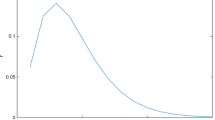Abstract
We introduce strong blender s. A strong blender Ble(·,·) uses weak sources X, Y to produce Ble(X,Y) that is statistically random even if one is given Y. Strong blenders generalize strong extractors [15] and extractors from two weak random sources [25,6]. We show that non-constructive strong blenders can extract all the randomness from X, as long as Y has logarithmic min-entropy. We also give explicit strong blenders which work provided the sum of the min-entropies of X and Y is at least their block length. Finally, we show that strong blenders have applications to cryptographic systems for parties that have independent weak sources of randomness. In particular, we extend the results of Maurer and Wolf [12] and show that parties that are not able to sample even a single truly random bit can still perform privacy amplification over an adversarially controlled channel.
Access this chapter
Tax calculation will be finalised at checkout
Purchases are for personal use only
Preview
Unable to display preview. Download preview PDF.
Similar content being viewed by others
References
Ajtai, M., Babai, L., Hajnal, P., Komlos, J., Pudlak, P.: Two lower bounds for branching programs. In: Proceedings of the eighteenth annual ACM symposium on Theory of computing, pp. 30–38 (1986)
Alon, N., Spencer, J.: The Probabilistic Method, 2nd edn. Wiley Interscience, New York (2000)
Andreev, A., Clementi, A., Rolim, J., Trevisan, L.: Dispersers, deterministic amplification, and weak random sources. SIAM J. on Comput. 28(6), 2103–2116 (1999)
Bennett, C.H., Brassard, G., Crépeau, C., Maurer, U.: Generalized Privacy Amplification. IEEE Transaction on Information Theory 41(6), 1915–1923 (1995)
Bennett, C.H., Brassard, G., Robert, J.-M.: How to reduce your enemy’s information. In: Williams, H.C. (ed.) CRYPTO 1985. LNCS, vol. 218, pp. 468–476. Springer, Heidelberg (1986)
Chor, B., Goldreich, O.: Unbiased bits from sources of weak randomness and probabilistic communication complexity. SIAM J. Comput. 17(2), 230–261 (1988)
Cohen, A., Wigderson, A.: Dispersers, deterministic amplification, and weak random sources. In: Proc. of FOCS, pp. 14–19 (1989)
Dodis, Y., Oliveira, R.: On extracting private randomness over a public channel (extended version), Available from http://www.math.nyu.edu/~oliveira/extracting.pdf
Dodis, Y., Spencer, J.: On the (Non-)Universality of the One-Time Pad. In: Proc. of FOCS (2002)
Janson, S., Luksak, T., Ruciński, A.: Random Graphs. Wiley Interscience, New York (2000)
Lu, C., Reingold, O., Vadhan, S., Wigderson, A.: Extractors: Optimal Up to Constant Factors. In: Proc. of STOC (2003)
Maurer, U., Wolf, S.: Privacy Amplification Secure Against Active Adversaries. In: Kaliski Jr., B.S. (ed.) CRYPTO 1997. LNCS, vol. 1294, pp. 307–321. Springer, Heidelberg (1997)
McInnes, J., Pinkas, B.: On the Impossibility of Private Key Cryptography with Weakly Random Keys. In: Menezes, A., Vanstone, S.A. (eds.) CRYPTO 1990. LNCS, vol. 537, pp. 421–435. Springer, Heidelberg (1991)
Nisan, N., Ta-Shma, A.: Extracting Randomness: a survey and new constructions. JCSS 58(1), 148–173 (1999)
Nisan, N., Zuckerman, D.: Randomness is Linear in Space. JCSS 52(1), 43–52 (1996)
Rónyai, L., Babai, L., Ganapathy, M.: On the number of zero-patterns in a sequence of polynomials Journal of the AMS (2002)
Sántha, M., Vazirani, U.: Generating Quasi-Random Sequences from Semi-Random Sources. Journal of Computer and System Sciences 33(1), 75–87 (1986)
Shaltiel, R.: Recent developments in Explicit Constructions of Extractors. Bulletin of the EATCS, vol. 77, pp. 67–95 (2002)
Shaltiel, R., Umans, C.: Simple extractors for all min-entropies and a new pseudo-random generator. In: Proceedings of FOCS 2001, pp. 648–657. IEEE Computer Society, Los Alamitos (2001)
Sipser, M.: Expanders, Randomness or Time versus Space. Journal of Computer and Systems Sciences 36, 379–383 (1988)
Ta-Shma, A., Radhakrishnan, J.: Bounds for Dispersers, Extractors, and Depth-Two Superconcentrators. SIAM Journal on Discrete Mathematics 13(1), 2–24 (2000)
Trevisan, L.: Construction of Extractors Using PseudoRandom Generators. In: Proc. of STOC, pp. 141–148 (1999)
Trevisan, L., Vadhan, S.: Extracting Randomness from Samplable Distributions. In: Proc. of FOCS (2000)
Vazirani, U.: Randomness, Adversaries and Computation. PhD Thesis, University of California, Berkeley (1986)
Vazirani, U.: Strong Communication Complexity or Generating Quasi-Random Sequences from Two Communicating Semi-Random Sources. Combinatorica 7(4), 375–392 (1987)
Vazirani, U., Vazirani, V.: Random polynomial time is equal to slightly-random polynomial time. In: Proc. of 26th FOCS, pp. 417–428 (1985)
Wigderson, A.: Open problems. In: Notes from DIMACS Workshop on Pseudorandomness and Explicit Combinatorial Constructions (1999)
Zuckerman, D.: Simulating BPP Using a General Weak Random Source. Algorithmica 16(4/5), 367–391 (1996)
Author information
Authors and Affiliations
Editor information
Editors and Affiliations
Rights and permissions
Copyright information
© 2003 Springer-Verlag Berlin Heidelberg
About this paper
Cite this paper
Dodis, Y., Oliveira, R. (2003). On Extracting Private Randomness over a Public Channel. In: Arora, S., Jansen, K., Rolim, J.D.P., Sahai, A. (eds) Approximation, Randomization, and Combinatorial Optimization.. Algorithms and Techniques. RANDOM APPROX 2003 2003. Lecture Notes in Computer Science, vol 2764. Springer, Berlin, Heidelberg. https://doi.org/10.1007/978-3-540-45198-3_22
Download citation
DOI: https://doi.org/10.1007/978-3-540-45198-3_22
Publisher Name: Springer, Berlin, Heidelberg
Print ISBN: 978-3-540-40770-6
Online ISBN: 978-3-540-45198-3
eBook Packages: Springer Book Archive



